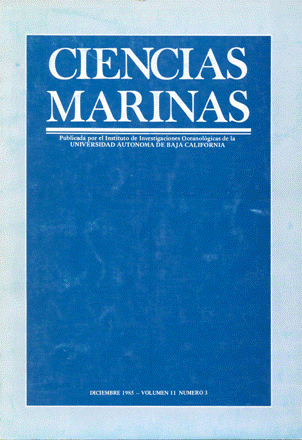Temporal and spatial variation of temperature in a winter habitat of the gray whale: Ojo de Liebre lagoon
Main Article Content
Abstract
We generated continuous temperature time series records, with in situ analogue recording thermographs, for three locations, at 6-g m depth, in the channels of Laguna Ojo de Liebre, Baja California Sur, during the period January 1985 to March 1986. The annual range in the lagoon was 13.5-26% We did not detect clear horizontal temperature gradients in the
channels, from location to location. However, during August and September the temperature increased from the mouth towards the interior, with -2ºC more in the internal extreme. Most temperature variance was in three period bands: variance of short period (with up to 2ºC of amplitude) mainly due to tidal currents and to the horizontal temperature gradients between the channels and the shallow areas of the lagoon; variance of intermediate period (one or two weeks, with up to 4ºC of amplitude) due, among other factors, to the sequence of upwelling events; and variance of long period (up to 12ºC) due to the seasonal sequence of solar irradiance and atmospheric temperature. Upwelling intensification events decrease the temperature of the lagoon by as much as 4ºC, and cause high organic fertility in it. During the stay period of the gray whale in Ojo de Liebre (end of November-March) the TºC range was from 13.5ºC to 19ºC.
Downloads
Article Details
This is an open access article distributed under a Creative Commons Attribution 4.0 License, which allows you to share and adapt the work, as long as you give appropriate credit to the original author(s) and the source, provide a link to the Creative Commons license, and indicate if changes were made. Figures, tables and other elements in the article are included in the article’s CC BY 4.0 license, unless otherwise indicated. The journal title is protected by copyrights and not subject to this license. Full license deed can be viewed here.

